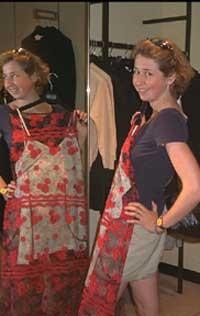Anti-odour garments
1999/03/14 Azkune Mendia, Iñaki - Elhuyar Fundazioa
Anti-odour garments are appropriating the market. Socks, briefs, culeros or "anti-bacteria" cubes are special and their function is to dignify the smell that occurs when skin secretions are degraded by bacteria.

The antibacterial tissue belongs to the bioactive family, that is, it is made of classic fibers (cotton, polyester, etc. ), but in them have added molecules of interest to the user. Antibacterial molecules are currently used in dresses, underwear, footwear, bedding or wool coils. In carpets, curtains and the like, anti-mite molecules are added. However, the path is open and in the future molecules can be incorporated to heal wounds, not grow hair, lose weight, hydrate, relax or improve blood circulation.
In the investigations initiated in Japan fifteen years ago with one hundred functional the objective is to find a procedure of integration in a molecule and tissue harmless and effective. As for bad odors, the tissue should come into contact with the skin without altering the biological balance.
The bad body smell is produced by millions of bacteria that are always found on the epidermis, especially in wet areas. The bacteria take the feed fat, cell waste and sweat emitted by the skin, generating metabolites that give off smell. To combat this annoying smell you have to control the bacteria, but you have to be careful. These bacteria adapted to the ecological state of the epidermis are beneficial to the skin, as they are an obstacle against other pathogenic microorganisms. If this obstacle is removed, the path will be free for any infection. Therefore, it is about being bacteriostatic (and not bactericidal), that is, the bacteria should not die, but should not be allowed to reproduce.
However, the death of bacteria is not the only danger. In fact, if the bacteria are found in the skin with a too high number of molecules, they get resistance to antiseptics and can be very harmful (if they enter the hospital, for example).
Despite the numerous studies carried out, there are no ideal molecules against bad odors. The most commonly used molecules in antibacterial tissues are triclosan and zeolite. Triclosana is widely used in hospitals as antiseptic, but is also used in dental pastes, shampoos, coal liquids, perfumes, etc. It is an effective bacteriostatic, but in theory it can produce resistant strains. Zeolite is a mineral molecule. It produces active oxygen in wet areas that inhibits bacteria. Less active than triclosana, but with a lower risk of resistant bacteria.
The molecules should be effective, but for a long time. They require a chemical and thermal stability to keep the clothes clean again and again. For this purpose, the type of molecule, the dose and the way it is introduced on or inside the fibres of the tissue is important.
Various types of tissue antibacteria
By fusion
The antibacterial molecules are mixed with a textile polymer cast at 300ºC. The mass so obtained is filtered under pressure and then spun. The antibacterial molecule is zeolite. This relatively thick mineral molecule hardly goes to the surface of the tissue and is less active than triclosana, but at 40°C it can withstand more than one hundred washes. Zeolite has ions of silver, copper and zinc and produces active oxygen that inhibits bacteria through mycoeletrolysis with sweat water.
Sedimentary sedimentary
Sedimentation of the antibacterial molecular layer in the tissue. This layer directly affects the bacteria of the skin. It is the most effective method, but when washing clothes the layer is removed. Suitable for one-use garments.
Squeeze tight
On the surface of the tissue a flexible layer is applied with antibacterial molecules. Being somewhat attached to the tissue, they last longer than those of sedimentation when washing clothes. They do not serve for more than 20 washes.
In addition to these systems stand out those of dissolution and microencapsulation. In the first, the antibacterial molecules are in dissolution with the granules of the textile polymer. The molecule used is a triclosana that easily migrates to the skin. It can withstand up to 40 washes. In the microencapsulation system, antibacterial molecules are collected in microcapsules, which are glued to tissue by deposition or squeeze. Some microcapsules are broken with the skin and the contents are removed. This system is still under investigation.
Published in 7

Gai honi buruzko eduki gehiago
Elhuyarrek garatutako teknologia




